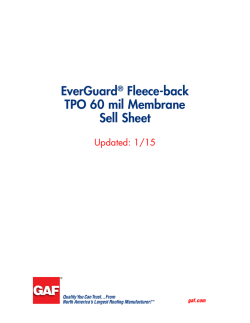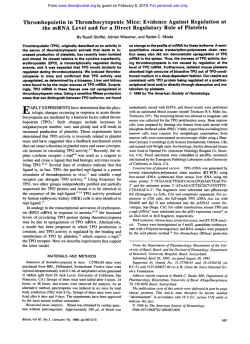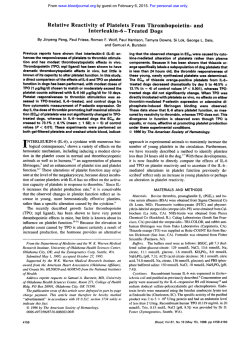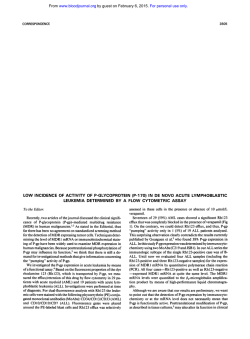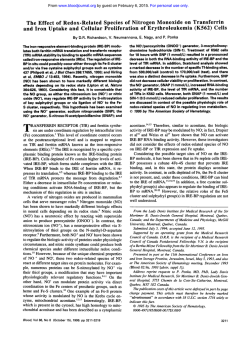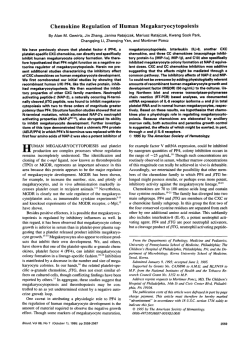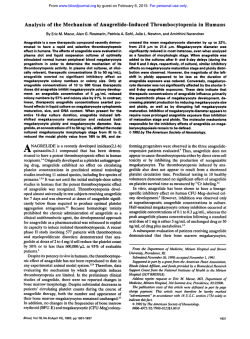
Murine Thrombopoietin mRNA Levels Are Modulated
From www.bloodjournal.org by guest on February 6, 2015. For personal use only. RAPID COMMUNICATION Murine Thrombopoietin mRNA Levels Are Modulated by Platelet Count By John M. McCarty, Katherine H. Sprugel, Norma E. Fox, Daniel E. Sabath, and Kenneth Kaushansky The activity of the c-Mpl ligand on hematopoietic progenitors meets criteria expected for thrombopoietin (TPO). Bioassays have shown that blood TPO levels are inversely related to platelet mass. We sought to identify the molecular basis for this regulation. To determine if TPO mRNA levels respond to platelet demand, RNA from selected organs of mice with high, normal, or low plateletcounts was subjected to semiquantitative reverse transcriptase-polymerase chain reaction. Although no differences in TPO mRNA levels between control and treated mice could be detected in liver or kidney, TPO-specific bands were more intense after 25 to 30 polymerase chain reaction cycles in marrow-derived mRNA from thrombocytopenic mice. The TPO-specific bands were less intense in thrombocytotic mouse marrow and spleen than control mouse marrow and spleen after 30 cycles. These data support the hypothesis that TPO levels are regulated, at least in part, by modulating mRNA levels in response to platelet demand. 0 1995 by The American Society of Hematology. T with the c-mpl cDNA (BAFJmpl), have been shown to correlate precisely with this in vivo activity.2’ Sera from mice rendered thrombocytopenic by either irradiation or after administration of rabbit antimouse platelet sera (RAMPS) contain high levels of this Mpl ligand, which is maximal shortly after the platelet nadir in these experiments. Similar results have been reported from other laboratories.I4.” Although regulation of TPO could occur at many levels, two possible mechanisms by which serum TPO activity may be regulated have been advanced in the literature. Based on the finding that platelets bear receptors for TPO, Kuter et allh.17 have proposed that TPO gene expression is constant HE LIGAND FOR the proto-oncogene c-mpl has been shown to meet a number of criteria expected of the primary regulator of megakaryocyte and platelet production, thrombopoietin (TPO). Althoughmany cytokines such as interleukin-3 (IL-3), IL-6, IL- 1 1, and leukemia-inhibitory factor (LIF) support the expansion of hematopoietic precursor cells and promote colony-forming unit-megakaryocyte (CFU-Mk) colony formation,’-’ liquid marrow culture, marrow colony assays, and in vivo studies have shown that these growth factors do not completely fulfill the operational definition of a putative thrombopoietic protein.’.‘-* In contrast, using similar methods, the Mpl ligand displays these expected activities; it supports megakaryocyte colony formation, increases megakaryocyte size and ploidy, induces the expression of lineage-specific differentiation markers, and is the most important regulator of megakaryocyte and platelet prod~ction.~.’ These data support the contention thatMpl ligand and plasma TPO are identical. As the physiologic regulator of platelet production, TPO levels wouldbe expected to vary inversely with platelet demand. Using radioisotopic incorporation into platelets in recipient animals as a bioassay for plasma TPO, Ode11et a14. I O showed an increase in serum TPO activity in response to decreasing platelet mass. These changes were associated with increased megakaryocyte number, size, andploidy within 6 to 24 hours and were maximal 96 hours after the onset of acute thrombocytopenia.5.’’-’3 Bioassays measuring the proliferation of a factor-dependent murine cell line BAFh303, which was stablytransfected From the Department of Medicine, Division of Hematology, and the Departments of Laboratory Medicine and Medicine, Division of Medical Genetics, University of Washington, Seattle, WA; and Zymogenetics, Inc, Seattle, WA. Submitted August I , 1995; accepted September 5, 1995. Supported by National institutes of HealthGrants No. R01 CA31615 and R01 DK49855 ( K . K . ) Address reprint requests to John M. McCarty, MD, Box 357710, Division of Hematology, University of Washington, Seattle, WA 98/95-7710. The publicationcosts of this article were defrayed in partby page charge payment. This article must therefore be hereby marked “advertisement” in accordance with 18 U.S.C. section 1734 sole1.y to indicate this fact. 0 1995 by The American Society of Hematology. 0006-497i/95/8610-0044$3.00/0 3668 andthat serum levels are controlled by the platelet mass through uptake and metabolism. Higher platelet counts would result in increased TPO catabolism, leading to a lower serum TPO levels. Conversely, a lower platelet mass would have less capacity for TPO uptake and metabolism, resulting in higher serum levels to act on megakaryocytes and their precursors. Such a schema has been proposed for regulation of serum macrophage colony-stimulating factor (M-CSF) levels by monocytes.” Alternatively, serum levels could be modulated by feedback regulation at the level of gene expression. Multiple studies have provided compelling evidence that serum erythropoietin levels are regulated by modulating expression of its gene.” TPO gene transcription could be inhibited or TPO-specific mRNA destabilized by high platelet counts; either of these processes could be countered by physiologic regulators that sense thrombocytopenia. These two models are not mutually exclusive, nor do they encompass all possible mechanisms by which TPO serum levels may be regulated. As a first step towards understanding the mechanisms that regulate TPO blood levels, we comparedthe levels of TPO-specific mRNAin the organs of mice with high, low, and normal platelet counts. Northern blot analysis identified the liver, the kidney, and, after longer exposure, the spleen as rich sources of TPOspecific transcripts.” Although marrowwasnottested in these initial studies, it was selected for study because of its potential physiologic relevance. Using a semiquantitative reverse transcription-polymerase chain reaction (RT-PCR) technique:’ we sought to correlate TPO-specific mRNA levels from these tissues with platelet counts. Although no noticeable differences between control and thrombocytopenic mice could be detected in liver or kidney, TPO-specific bands were more intense in marrow-derived mRNA in both Blood, Vol 86, No 10 (November 15), 1995: pp 3668-3675 From www.bloodjournal.org by guest on February 6, 2015. For personal use only. 3669 MURINE THROMBOPOIETIN MRNA REGULATION RAMPS-treated and irradiated miceand in spleen-derived mRNA in RAMPS-treated animals. The TPO-specific bands were less intense in thrombocytotic mousemarrowand spleen than in controls. The findings that TPO mRNA levels are upregulated in marrow and spleen by thrombocytopenia and may be downregulated by TPO induced thrombocytosis support the hypothesis that TPO levels are regulated, at least in part, by alterations in steady-state mRNA levels. 1:5 Liver Liver 20 25 30 20 25 30 MATERIALS AND METHODS Animal preparation. Female CS7B1/6 mice of S to 6 weeks of age were studied in four separate groups. All groups had baseline and posttreatment peripheral blood counts determined by Cell-Dyn 3000 counter (Abbott Laboratories, North Chicago, IL). After killing the mice, liver, spleen. both kidneys, and femurs were obtained from each mouse and flash frozen in liquid nitrogen. Experiment I consisted of two mice. One mouse was exposed to a single dose of SS0 Cy from a cesium source (Gammacell 40 Irradiator; Atomic Energy of Canada, Ltd. Kanata, Ontario, Canada) and received 1.2 mg of carboplatinum (Bristol Meyers-Squibb Oncology Division, Princeton, NJ) intraperitoneally (IP). Another untreated mouse remained as control. Both mice were killed at day 13. Experiment 2 consisted of three mice. One mouse was exposed to a single dose of 600 Cy from a cesium source and received I .2 mg of carboplatinum IP. A second mouse was treated with recombinant murine TPO (Zymogenetics Inc, Seattle, WA) at 12.000 U IP daily and a thirdwith TPO vehicle IP daily. All mice were killed after 16 days. Experiment 3 consisted of three mice. One mouse received two daily doses of 1 0 0 pL RAMPS (kindly supplied by G. Roth, VAMC. Seattle, WA) IP andwaskilled after 96 hours. One mouse was treated with 12,000 U recombinant murine TPO IP daily for 7 days and another with TPO vehicle alone for 7 days before death. Experiment 4 consisted of 4 mice treated with daily doses of 175 pL RAMPS IP on day 1 and one untreated control mouse. Two of the mice received 125 pL IP doses on subsequent days. Because the maximal effect of RAMPS on platelets is seen by 6 hours, one mouse was killed daily 6 hours after the RAMPS injection on days I , 2, and 3. The fourth treated mouse died before the fourth dose of RAMPS could be administered of an acute hemorrhagic diathesis. The fifth mouse remained untreated on these successive dosing days. RNA isolation. Tissues were disrupted in an 1 1 molL guanidium thiocyanate solution using a Polymizer (Polytron Drives, Patterson, NJ) tissue homogenizer. Total cellular RNAwas obtained using the RNAgents Total Cellular RNA Isolation Kit (Promega Corp, Madison. WI) according to the manufacturer’s directions. RT-PCR. In batchedand parallel reactions, equal amounts of total cellular RNA from each control and treated mouse organ were subjected to reverse transcription with an oligo dT,, primer (Pharmacia Biotech Inc. Piscataway, NJ) using the Superscript II system (GIBCO BRL, Gaithersburg, MD) according to the manufacturer’s specifications. One tenth of the reverse transcription reaction was subjected to PCR in parallel using Amplitaq (Applied Biosystems, Foster City. CA). A 717-bp fragment was obtained using the oligonucleotides + S4 (5’-TCTGTCCAGCCCCGTAGGTC) +73 and +771 (S’-GTTCCATCCACAGGTCCGTG) +75 1. Batched reactions for each reverse transcribed RNA species were separated into 30-pL aliquots, subjected to at least three different numbers of PCR cycles, and size fractionated on agarose gels. These same reverse transcription reactions were subjected to 20 cycles ofPCRwith limiting concentrations of primers specific for glyceraldehyde-3-dehydrogenase (GAPDH) +S70 (S-CAAAGTTGTCATCGATGACC) +SS0 and +376 (CCATGGAGAAGGCTGGGG) +394 to serve as an RNA loading and reverse transcription control. The number of PCR Fig 1. Semiquantitative RT-PCR can detect variations in TPO-specific mRNA levels. RT-PCR performed in parallel as described in the Materials and Methods on liver total cellular RNA diluted 1:5 with RNAse-free water (1:5 LIVER) and undiluted liver total cellular RNA (LIVER).Negative and positive control lanes labeled 0 and +, respectively. Arrow marks the major band under study corresponding to TPO 1 and TPO 2; the minor band corresponding to TPO 3 PCR product is seen beneath. cycles were chosen so that the relative intensity of the bands seen on agarose gels would belinearly related to the relative concentration of the TPO-specific mRNA species present in the reverse transcription reactions. Seqrtencing qfRT-PCR prohcfs. To confirm the identity of the PCR products. representative RT-PCR reactions were electrophoresed in agarose gels, the bands were excised, and DNA was recovered using Geneclean (Bio 101, Vista, CA) according to the manufacturer‘s recommended protocol. After subcloning into pGEM-T (Promega Corp. Madison, WI), positive clones were pickedand grown out and plasmids were isolated by alkaline lysis followed by polyethylene glycerol precipitation. Using a primer that recognized the l7 (S’-TAATACGACTCACTATAGGG) or the SP6 (S‘-GATTTAGGTGACACTATAG) promoter sequence of pGEM-T, several clones were sequenced using the Taq Dye-Deoxy Dye Terminator a 370A Cycle Sequencing Kit (Applied Biosystems) andrunon automated Sequencer (Applied Biosystems) to verify that they were derived from mTPO. RESULTS TPO mRNA detected by RT-PCR is predominantly TPO 1. Gurney et al.’2 report two TPO isoforms, TPO2 and TPO 3, that differ from full length TPO 1 by 12-bp and 1 12bp deletions, respectively, leading to truncation in the fourth exon. Of eight clones sequenced, six contained sequences consistent with full-length TPO 1 and two werefound to contain the 12-bp deletion that characterizes TPO 2. The truncated form, TPO 3, could be differentiated by size using these primer pairs and could onlybe appreciated after 30 cycles of PCR. The minor band seen in Fig 1 is consistent with TPO 3. Thus, the RT-PCR method on which this study is based predominantly recognizes the active isoform TPO 1 with some minor contribution of the poorly secreted TPO 2 and TPO 3 forms. E e c t qf experimental conditionsonperipheralblood counts. The results of posttreatment complete blood counts from each set of mice are shown in Table 1. Both radiation and RAMPS treatment regimens resulted in moderate to severe thrombocytopenia, with the mostprofound decrease seen after successive doses of RAMPS in experiment 4. All concentrations of recombinant TPO (rTP0) used in this study induced substantial thrombocytosis. From www.bloodjournal.org by guest on February 6, 2015. For personal use only. McCARTY ET AL 3670 Table 1. Effect of Experimental Conditions on Peripheral Blood Counts of Study Mice as Measured on Coulter Counter Experimental Group 1 2 3 4 PLT Condition Control XRT/Carboplatinum Control RAMPS 100 U lP/7 d TPO 12,000 U lP/7 d Control XRT/Carboplatinum TPO 12,000 U IP/16 d Control RAMPS 6 h RAMPS 30 h RAMPS 54 h WBC 1335.041.2 2.0 0.2 67.0 1184.041.3 4.0 65.039.1 4.1 3244.0 5.3 775.049.0 13.5 25.0 7.5 3915.038.0 10.0 945.0 5.5 80.0 2.0 20.0 2.0 8.0 0.6 HCT 5.7 44.6 <5 46.0 29.0 25.0 6.0 Experimental groups as designated in the Methods and Materials section. Abbreviations: WBC, white blood count per microliter; HCT, hematocrit; PLT, platelet count per microliter. Semiquantitative RT-PCR can detect variations in TPOspecijc mRNA levels. The semiquantitative RT-PCR technique used in this study capitalizes on the fact that PCR bands derived from more abundant mRNA species will be detected after fewer cycles of RT-PCR than those that are present in lower concentrations. To show the ability of this method to detect differences in mRNA concentrations, we performed the technique on RT-PCR reactions containing decreasing concentrations of liver RNA. Figure 1 compares the TPO-specific PCR band intensities using two serial fivefold dilutions of liver RNA. As expected, a more intense TPO-specific band is seen at 25 and 30 cycles in the fivefold more concentrated sample. Below the major PCR band, the minor band contributed by the TP03 isoform at 30 cycles can be seen. This established that this technique could be used to detect differences in TPO-specific mRNA. Although RNAineach experimental group was subjected to these same conditions in parallel, comparison of band intensity was found to be more efficient if photos of the gels were cut out and rearranged, as seen in Fig 2. Liver 28 25 31 Kidney 25 28 31 Spleen 28 25 31 TPO-spec@ mRNA increases afrer irradiatiodcarboplatinum therapy. Figure 2 displays the results of the semiquantitative RT-PCR on RNA samples from experiment 1. The relative intensity of TPO-specific bands in the control and treated reactions are similar through 31 cycles of PCR of liver- and kidney-derived mRNA. However, in treated marrow. a more intense band can be seen after28 cycles compared with control, indicating a higher TPO mRNA concentration after irradiation. A less dramatic increase can also be seen in treated spleen after 31 cycles. Cornparison of PCR bands for GAPDH from each organ-derivedmRNAshowsthatequalamounts of reverse transcribedmRNAwerepresent in each PCRreaction. To extend these results, we performed a second experiment, this time includinga rTP0-treated animal. Figure 3 confirms earlier results that no significant differences be candiscerned in control myelosuppressed or rTPO-treated liver or kidney samples from experiment 2. The presence of more prominent bands in radiated versus control marrow and spleen lanes as well as absent bands in the rTPO-treated marrow and spleen lanes support the conclusion that TPO mRNA can be modulated in response to changes in platelet counts. TPO-specijc mRNA responds to changes in platelet counts mediated by RAMPS. To study the regulation of TPO mRNA levels further, we used a second independent method for induction of acute thrombocytopenia. Comparison of the TPO-specific PCR bands from vehicle, rTP0-, and RAMPS-treated mice in Fig 4 again shows that thrombocytopenia failed to alter TPO mRNA levels in liver or kidney. As was seen after myelosuppression-inducedthrombocytopenia, a substantial increase in band intensity can be seen in the marrow and spleen of RAMPS-treated mice. In addition, a decrease inband intensity isseen in marrow derived from the rTPO-treated animal. Comparison of control and rTPO-treated spleen is inconclusive given the low intensity of the control band. These results suggest that, in marrow and, to a lesser extent, in spleen, TPO mRNA levels increase in response to acute thrombocytopenia and decrease with thrombocytosis. The RAMPS-treated mice in experiment 4 achieved the most profound thrombocytopenia of all those tested. Examination of the relative band intensities shown in Fig 5 again Marrow 2825 cDNA 31 LC Lx Kc K x Sc Sx MC Mx 0 Fig 2. TPO-specific mRNA increases after irradiationlcarboplatinumtherapy. Results of semiquantitative RT-PCR on liver, kidney, spleen, and marrow-derived total cellular RNA from untreated and carboplatinumlradiation-treatedmice as described in the Materials and Methods. Reactions were run for 25, 28, or 31 cycles. The positive control lane is labeled cDNA. GAPDH control reactions after 20 cycles are included untreated kidney (Kc), treated kidney [ K x ) , untreated spleen (Sc), treated spleen for each RNA studied: untreated liver (LC), treatedliver (h), 6x1, untreated marrow (MC),treated marrow (Mx),and negative control ( 0 ) . OPOIETIN From www.bloodjournal.org by guest on February 6, 2015. For personal use only. MURINE 3671 Liver Kidney Spleen Marrow 0/cDNA Vehicle WCarbo TPO 25 28 31 25 28 31 28 25 31 25 28 31 1$ GAPDH LC L x Lt Kc Kx Kt Sc Sx St MC MxMt 0 Fig 3. TPO-specific mRNA responds t o changes in platelet counts mediated by irradiationlcarboplatinum(XRTlCarbol treatment. Results of semiquantitative RT-PCR on liver, kidney, spleen, and marrow-derived totalcellular RNA from untreated, RAMPS-, and recombinant mTPOtreated miceas described in the Materials andMethods. Reactions were run for25,28, or 31 cycles. Negative control (01and positive control lanes IcDNA) are shown. GAPDH control reactions after 20 cycles are included for each RNA sample: untreated liver (LC), XRTICarbo-treated liver (h), TPO-treated liver (Lt), untreated kidney (Kc), XRTICarbo-treated kidney (Kx), TPO-treated kidney (Kt), untreated spleen (Scl, XRTl Carbo-treated spleen (Sx), TPO-treated spleen (St), untreated marrow (MC),XRTlCTx-treated marrow (Mx), TPO-treated marrow (Mtl, and negative control (0). ment could possibly introduce a sampling bias. Because the shows that no changes in TPO-specific mRNA can be detected in liver or kidney derived lanes, but that bands show same results were seen with either radiation of RAMPS inincreased intensity in RAMPS-treated marrow and spleen. duction of thrombocytopenia, it became important to know Although this effect can be seen as early as 6 hours after whether these manipulations altered the cellularity or compoRAMPS administration, it is most apparent after 30 and 54 sition of marrow. Figure 6 shows photomicrographs of huhours of acute thrombocytopenia. meri taken from the same mice used in experiments 1 and RAMPS treatment does not affect marrow cellularity or 4. Compared with the normally100% cellular marrow of the control mouse in Fig 6A, the myelosuppressed mouse composition. In the present study we used two well-established methods to induce severe thrombocytopenia, ie, myelo- marrow was hypocellular, with a predominance of marrow stromal cells, histiocytes, and plasma cells (Fig 6B). As exsuppressive therapy and antiplatelet antisera. These methods may affect the cellular composition of spleen and marrow; pected, the administration of rTP0 resulted in substantial thus, it is possible that the induction of thrombocytopenia megakaryocyte expansion (Fig 6C). However, examination of the humeri taken from each of the RAMPS-treated mice may have altered the relative proportion of TPO-producing shown in Fig 6D through F showed no change in overall cells in these organs. The end result could be an artificial enrichment for TPO mRNA. RT-PCR surveys of primary cellularity or cellular composition compared with the control cell cultures and of cell lines performed in our laboratory mouse. On the marrow corresponding to the 54 hours of have shown that stromal elements are a source of TPORAMPS exposure, which is when the biologic effect of TPO specific mRNA in marrow, suggesting that relative enrichis first seen in various biologic and marrow colony assays, Liver Fig 4. TPO-specific mRNA responds t o changes in platelet counts mediated byRAMPS. Results RT-PCR on liver, kidney, spleen, and marrow-derivedtotal cellular RNA from untreated, RAMPS, and recombinant mTPO-treated mice as described in the Materials and Methods. Reactions were run for 25, 28, or 31 cycles. Negative control (0) and positive control lanes (cDNA) are shown. GAPDH control reactions after 20 cycles included for each RNA sample. Kidney Spleen Marrow 0/cDNA Vehicle RAMPS TPO 28 25 31 28 25 31 LC L r LtKcKrKt 28 25 31 Sc Sr StMC 25 28 31 Mr M t 0 From www.bloodjournal.org by guest on February 6, 2015. For personal use only. McCARTY ET AL 3672 Liver Kidney Spleen Marrow 0/cDNA Vehicle 6 Hrs RAMPS I 30 Hrs RAMPS 54 Hrs RAMPS 20 25 30 20 25 30 20 25 30 20 25 30 GAPDH LcLbL30L54KcK6K30K56ScS6S30S54McM6M30M.54 Fig 5. TPO mRNA increases can be detected 6 hours after RAMPS administration. Results of semiquantitative RT-PCR on liver, kidney, spleen, and marrow-derived total cellular RNAfrom untreated and RAMPS-treated mice as describedin the Materials and Methods. Reactions were run for 20, 25, or 30 cycles. Negative control ( 0 )and positive control lanes (cDNA) are shown. GAPDH control reactions after 20 cycles are included for each RNA sample: untreated liver (LC), 6-hour RAMPS-treated liver (L6). 30-hour RAMPS-treated liver IL30).--hour RAMPStreated liver (L541, untreated kidney (Kc), 6-hour RAMPS-treated kidney (K6). 30-hour RAMPS-treated kidney (K30). %-hour RAMPS-treated kidney (K54). untreated spleen (Scl, 6-hour RAMPS-treated spleen (S6), 30-hour RAMPS-treated spleen (S301,54-hour RAMPS-treated spleen 6541, untreated marrow (MC), 6-hour RAMPS-treated marrow (M6), 30-hour RAMPS-treated marrow (M30), and 54-hour RAMPS-treated marrow (M54). a substantial increase in megakaryocyte number and size can be seen (Fig 6F). These data would indicate that the increase in TPO-specific mRNA after RAMPS-induced thrombocytopeniaisnot due to a gross change in the composition or cellularity of the marrow. TPO qfects on marrowcomposition nnd cellularity. Fromthe photomicrograph of marrow derived fromthe rTPO-treated mouse seen in Fig 6, substantial expansion of the megakaryocyte compartment without change in overall cellularity is evident. On these animals, the megakaryocyte mass accounts for nearly 30% of the marrow space. Because these cells contribute a significant proportion of the mRNA in these tissues, it also became important to know whether megakaryocytes contained TPO-specific mRNA. Using the same experimental conditions used in this study, TPO mRNA could not be detected from purified megakaryocytes despite 80 cycles of RT-PCR (data not shown). However, this implies that the reduction in band intensity seen in the marrow and spleen from rTPO-treated animals might be explained, at least in part, by relative dilution from megakaryocyte-derived mRNA. DISCUSSION The gene for the Mpl ligand, TPO, has recentlybeen cloned by a number of groups. Work by Wendling et al,” has shown that virtually all of the thrombopoietic activity of thrombocytopenic plasmacanbe accounted for by the Mpl ligand, thereby supporting earlier studies that suggest that TPO protein levels are inversely related to platelet counts. In this study, we sought to determine whether TPOspecific mRNA levels vary in tissues and could therefore account for changes in serum TPO concentration. To do so, we developed a semiquantitative RT-PCR-based assay that could easily detect TPO-specific transcripts in liver, kidney, spleen, and marrow. Because mRNA was made from whole tissue extracts, itis impossible for usto determine from this study which cells in these tissues are the site of TPO production. It is possible that a common cell type found in all these tissues, such as endothelial cells, fibroblasts. or tissue macrophages, is the source of TPO production. Surveys of several cell lines, including primary and transformed endothelial cells and fibroblasts, have shown them to express TPO message and protein. Although some inferences can be made from RT-PCR in cell lines, the cellular localization of TPO awaits the completion of in situ hybridization experiments, which are already underway. Two models of TPO gene regulation have been proposed. In the first, serum levels are maintained solely by platelet uptake and metabolism of TPO. In the second, platelet levels are sensed. resulting in appropriately increased or decreased levels of TPO gene expression. The phenotype of a recently reported NF-E2 knockout mouse lends credence to the assertion that platelet metabolism of TPO is not the sole determinant of serum TPO levels. In the NF-E2 -” phenotype, although platelet counts are low, serum TPO levels remain normal.” TPO levels in these transgenic mice are therefore discordant with those expected from a purely catabolic model. The precise impact of the NF-E2”- phenotype on the modulation of TPO mRNA levels in response to thrombocytopenia cannot be determined completely, whereas no difference in liver TPO mRNA levels was seenbetween control and mutant mice; spleen- and marrow-derived RNA was not tested in their study. From www.bloodjournal.org by guest on February 6, 2015. For personal use only. MURINE THROMBOPOIETIN MRNA REGULATION 3673 Fig 6. Effect of irradiationlcarboplatinum. RAMPS, and TPO administration on marrow composition and cellularity. Photomicrographs of hematoxylin and eosin stained humeral cross-sections from mice killed in experiments 1 and 4. (A) Control mouse; (B) rnyelosuppressed and carboplatinurn-treatedmouse; (C) recombinant murine TPO at 12,000 U IP per day-treated mouse; (D) 6-hour RAMPS-treated mouse; (E) 30hour RAMPS-treated mouse; and (F)54-hour RAMPS-treated mouse. Original magnifications: (A and C through F) x 10, (B) x 50. Further support for an inductive model of TPO gene regulation can be found in the observations of Wendling et al" in RAMPS-treated mice. Whereas a modest increase in serum TPO activity could be detected at the time of platelet nadir in a BAFdmpl proliferation assay, peak serum activity was seen at 24 hours after RAMPS administration. These same observations were also reported by Hunt et al.'4 In a murine model of immune-mediated thrombocytopenia, peak serum TPO levels were detected not at the time of platelet nadir, which occurred at 8 hours, but rather at 24 hours after treatment. From their findings, Hunt et al" considered the delayed activity peak to represent the time required for TPO gene induction, as well as TPO protein production and accumulation. This response profile is consistent with the induction of TPO-specific mRNA in the RAMPS-treated mice reported in the present study. The results reported here indicate at least one molecular basis for TPO regulation. The semiquantitative method used in this study shows that differences in mRNA levels detected in some organs must be due to either transcriptional or posttranscriptional regulatory mechanisms. From Northern blot analysis, it is obvious that the liver and the kidney are the From www.bloodjournal.org by guest on February 6, 2015. For personal use only. 3674 two most predominant sites of TPO mRNA.'4,20However, these two tissues do not exhibit modulation of TPO mRNA in response to changes in platelet counts in our study. In the spleen and marrow, perhaps themore physiologically relevant tissues for thrombopoiesis, TPO-specific mRNA levels were found to be inversely related to platelet counts. Although this does not exclude a role for platelet catabolism in maintaining appropriate serum TPO levels, it does provide evidence for an alternative mechanism regulating TPO in serum in response to changes in platelet counts. Thus, at least in marrow and spleen, mRNA is either transcriptionally induced or stabilized. However, the magnitude by which TPO mRNA levels change in both spleen and marrow cannot be assessed for comparison with the degree by which TPO protein activity and levels change in serum. Correlation of serum TPO activity and serum and cellular protein levels with mRNA production from these tissues is required to address quantitative aspects of TPO expression. It is anticipated that the modulation of mRNA levels seen in mouse spleen may not be seen in human splenic tissues because of the greater functional role of the spleen as a site of hematopoiesis in the mouse. Nonetheless, these findings in mice can likely be extrapolated to human marrow. Studies of the mRNA isoforms reported by Gurney et aIz2 have shown that only the full-length TPO mRNA is secreted and accounts for the serum TPO activity seen in thrombocytopenia. It is important to note that the majority of mRNA that comprise the major PCR products in this study encode for the full-length biologically active form of TPO, with only a minor contribution of the nonsecreted, inactive TPO 2 form. TPO 3 could be detected only in insignificant amounts. Changes in the relative ratios of these forms may well represent a regulatory mechanism; this hypothesis may be tested by subcloning and sequencing the RT-PCR products from each of these tissues in the presence and the absence of a thrombocytopenic stimulus. From the results obtained in this study some generalities can be made about the time course of the TPO mRNA response to thrombocytopenia. From experiment 4,in which mice were killed 6 hours after each successive dose of RAMPS, it appears that a small but discernible increase in TPO mRNA can be detected in spleen and marrow as early as 6 hours after the onset of acute thrombocytopenia. This increase continues to 30 hours and, although no difference can be seen in this study between 30 and 54 hours after the induction dose of RAMPS, the band intensity remains higher than control through this time period. Data from the myelosuppressed mice that were killed after day 16 showed an increased level of TPO mRNA, suggesting that, in this model, TPO mRNA remains high in marrow and spleen as long as the platelet count remains low. Thus, although the response of TPO mRNA in marrow andspleen is fairly rapid, by 6 hours, with peak levels by 30 hours, it is also longlasting, suggesting an ongoing signal that results in higher TPO mRNA levels. Likewise, the reduction in TPO mRNA levels in response to exogenously administered rTPO-induced thrombocytosis can be seen for 16 days. Although it is not certain that this is due solely to modulation of mRNA levels or due to relative dilution of TPO mRNA by increased McCARTY ET AL amounts of megakaryocyte RNA, it is consistent with the data from the thrombocytopenic animals. This issue can be further addressed by studying mice hypertransfused with platelets to avoid disturbing the megakaryocyte compartment of the marrow. Further studies examining the effect of platelet recovery after thrombocytopenia on TPO mRNA levels in this myelosuppressed model would also be informative. The nature or the source of the signal that allows tailoring of TPO mRNA levels to platelet demand is not clear from our data and is the basis of ongoing study. It is also apparent from examination of the peripheral blood counts performed on the mice from these studies that, in addition to thrombocytopenia, carboplatinudradiation as well as RAMPS treatment affects the peripheral red blood cell and whiteblood cell compartments. Because several additional cytokine levels would be expected to be elevated in these animals (eg, erythropoietin, GM-CSF, and G-CSF), it is possible that the stimulus for TPO mRNA induction may not be due to isolated thrombocytopenia alone. However, in the RAMPS-treated mouse of experiment 1, no effect is seen on either the white blood cell count or hematocrit. Thus, it appears that TPO &A can be induced in the absence of anemia or leukopenia. This study provides an initial insight into the molecular mechanisms that regulate expression of the TPO gene. Current and future efforts are directed at more precise quantitation and the cellular localization of TPO mRNA. The development of in vitro models of TPO production and studies including nuclear run-on assays and mFWA half-life determinations will be required to confirm the constitutive nature of TPO expression in liver and kidney and to determine relative contributions of transcriptional and posttranscriptional mechanisms that regulate TPO mRNA levels in response to changes in platelet mass. It is hoped that a better understanding of the molecular processes that regulate this important mediator of thrombopoiesis will lead to greater insights into the process of hematopoiesis as a whole. ACKNOWLEDGEMENT TheauthorsthankDr Steve Collins for his contributions to the preparation of this manuscript and Jackie Humes for her technical advice on the preparation of the murine models. REFERENCES 1. Hill W,Warren MK, LevinJ, Gauldie J: Evidence that interleukin-6 does not play a role in the stimulation of platelet production after induction of acute thrombocytopenia. Blood 80:346, 1992 2 . Debili N, Masse JM,Katz A, Guichard J, Breton-Gorius J, Vainchenker W: Effects of the recombinant hematopoietic growth factorsinterleukin-3,interleukin-6,stem cell factor,andleukemia inhibitoryfactor on themegakaryocyticdifferentiation of CD34' cells. Blood 82:84, 1993 3. Kaushansky K, Lok S, Holly R D , Broudy VC, Lin N, Bailey MC, Forstrom J W , Buddle MM, Oort PJ, Hagen FS,Roth GJ,Papayannopoulou T, Foster DC: Promotionof megakaryocyte progenitor expansion and differentiation by the c-Mpl ligand thrombopoietin [see comments]. Nature 369:568, 1994 4. Ode11 lT, JacksonCW,FridayTJ,CharshaDE:Effects of thrombocytopenia on megakaryocytopoiesis. Br J Haematol 17:91, 1969 From www.bloodjournal.org by guest on February 6, 2015. For personal use only. 3675 MURINE THROMBOPOIETINMRNAREGULATION 5. Odell TT, Jackson CW, Murphy J R Platelet recovery after induction of acute thrombocytopenia. Proc Soc Exp Biol Med 148:829, 1975 6. Williams N: Is thrombopoietin interleukin 6? Exp Hematol 19:714, 1991 7. Neben T Y , Loebelenz J, Hayes L, McCarthy K, Stoudemire J, Schaub R, Goldman SJ: Recombinant human interleukin-l 1 stimulates megakaryocytopoiesis and increases peripheral platelets in normal and splenectomized mice. Blood 81:901, 1993 8. Metcalf D, Waring P, Nicola NA: Actions of leukaemia inhibitory factor on megakaryocyte and platelet formation. Ciba Found Symp 167:174,1992 9. Gurney AL, Carver-Moore K, de-Sauvage FJ, Moore M W : Thrombocytopenia in c-Mpl-deficient mice. Science 265:1445, 1994 10. Odell TT, Jackson CW, Friday TJ, Du KY: Assay of megakaryocytopoiesis in thrombocytopenic rats. Br J Hematol 21:233, 1971 11. Kuter DJ, Rosenberg RD: Regulation of megakaryocyte ploidy in vivo in the rat. Blood 75:74, 1990 12. Jackson CW, Edwards CC: Platelet production capacity at intervals after acute thrombocytopenia. Scand J Haematol 17:285, 1976 13. Miura M, Jackson CW, Lyles SA: Increases in circulating megakaryocyte growth-promoting activity in the plasma of rats following whole body irradiation. Blood 63:1060, 1984 14. de Sauvage FJ, Hass PE, Spencer SD, Malloy BE, Gurney Spencer SA, Darbonne WC, Henzel WJ, Wong SC, Kuang WJ, Oles U,Hultgren B, Solberg LA, Goeddel DV, Eaton DL: Stimulation of megakaryocytopoiesis and thrombopoiesis by the cMpl ligand [see comments]. Nature 369:533, 1994 15. Bartley T D , Bogenberger J, Hunt P, Li YS, Lu HS, Martin F, Chang MS, Samal B, J.L. N, Swift S, Johnsom MJ, Hsu RY, Parker VP, Suggs S, Skrine J D , Merewether LA, Clogston C, Hsu E, Hokom MM, Homkol A, Choi E, Pangelinan M, Sun Y, Mar V, McNinch J, Simonet L, Jacobsen F, Xie C, Shutter J, Chyte H, Basu R, Selander L, Trollinger D, Sieu L, Padilla D, Trail G, Elliot G, Izumi R, Covey T, Crouse J, Garcia A, Xu W, Del Castillo J, Biron J, Cole S, Hu MCT, Pacifici R, Ponting I, Saris C, Wen D, Yung YP, Lin H, Bosselman RA: Identification and cloning of a megakaryocyte growth and development factor that is a ligand for the cytokine receptor Mpl. Cell 77:1117, 1994 AL. 16. Kuter DJ, Beeler DL, Rosenberg RD: The purification of megapoietin: A physiological regulator of megakaryocyte growth and platelet production. Proc Natl Acad Sci USA 91:11 104, 1994 17. Kuter DJ, Rosenberg RD: The reciprocal relationship of thrombopoietin (c-Mpl ligand) to changes in the platelet mass during busulfan-induced thrombocytopenia in the rabbit. Blood 85:2720, 1995 18. Bartocci A, Mastrogiannis DS, Migliorati G, Stockert RJ, Wolkoff AW, Stanley ER: Macrophages specifically regulate the concentration of their own growth factor in the circulation. Proc Natl Acad Sci USA 84:6179, 1987 19. Goldberg MA, Gaut CC, Bunn HF: Erythropoietin mRNA levels are governed by both the rate of gene transcription and posttranscriptional events. Blood 77:271, 1991 Kuijper JL, Lofton-Day 20. Lok S, Kaushansky K, Holly CE, Oort PJ, Grant FJ, Heipel MD, Burkhead SK, Kramer J M , Bell AM, Sprecher CA, Blumberg H, Johnson R, Prunkard D, Ching AFT, Mathewes SL, Bailey MC, Forstrom J W , Buddle MM, Osbom SG, Evans SJ, Sheppard PO, Presnell SR, O’Hara PJ, Hagen FS, Roth GJ, Foster DC: Cloning and expression of murine thrombopoietin cDNA and stimulation of platelet production in vivo [see comments]. Nature 369:565, 1994 21. Shivdasani RA, Rosenblatt MF, Zucker-Franklin D, Jackson CW, Hunt P, Saris CJM, Orkin SH: Transcription factor NF-E2 is required for platelet formation independent of the actions of thrombopoietinMGDF in megakaryocyte development. Cell 81:695, 1995 22. Gurney AL, Kuang WJ, Xie MH, Malloy BE, Eaton DL, de-Sauvage FJ: Genomic structure, chromosomal localization, and conserved alternative splice forms of thrombopoietin. Blood 85:981, 1995 23. Wendling F, Maraskovsky E, Debili N, Florindo C, Teepe M, Titeux M, Methia N, Breton-Gorius J, Cosman D, Vainchenker W: cMpl ligand is a humoral regulator of megakaryocytopoiesis [see comments]. Nature 369:571, 1994 24. Hunt P, Li YS, Nichol JL, Hokom MM, Bogenberger JM, Swift SE, Skrine JD, Hornkol AC, Lu H, Clogston C, Merewether LA, Johnson MJ, Parker V, Knudten A, Farese A, Rou YH, Garcia A, Stead R, Bosselman RA, Bartley TD: Purification and biologic characterization of plasma-derived megakaryocyte growth and development factor. Blood 82:540, 1995 RD. From www.bloodjournal.org by guest on February 6, 2015. For personal use only. 1995 86: 3668-3675 Murine thrombopoietin mRNA levels are modulated by platelet count JM McCarty, KH Sprugel, NE Fox, DE Sabath and K Kaushansky Updated information and services can be found at: http://www.bloodjournal.org/content/86/10/3668.full.html Articles on similar topics can be found in the following Blood collections Information about reproducing this article in parts or in its entirety may be found online at: http://www.bloodjournal.org/site/misc/rights.xhtml#repub_requests Information about ordering reprints may be found online at: http://www.bloodjournal.org/site/misc/rights.xhtml#reprints Information about subscriptions and ASH membership may be found online at: http://www.bloodjournal.org/site/subscriptions/index.xhtml Blood (print ISSN 0006-4971, online ISSN 1528-0020), is published weekly by the American Society of Hematology, 2021 L St, NW, Suite 900, Washington DC 20036. Copyright 2011 by The American Society of Hematology; all rights reserved.
© Copyright 2025

